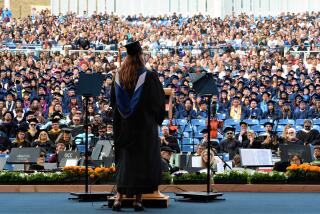Department’s Scope Keeps Dancers on Their Toes
- Share via
Orange Coast College was founded in 1947 and currently has about 25,000 students. It’s hard to tell exactly how many of them enroll in the 50 dance classes offered each semester, but it’s sizable.
“We say 900 to 1,000 seats are taken each semester,” said Karen Shanley, dance department chair. “As far as the exact number of people, it’s hard to determine [because] some students take more than one class.”
Classes include ballet, modern, jazz and tap, but also “a very extensive world dance program--two levels of flamenco, two levels of Middle Eastern dance, East Indian, Spanish classical and a popular class on African dance--although we recently lost the instructor because she took a full-time position elsewhere,” Shanley said.
The dance department, founded in 1962, also offers the only vocational certificate programs in dance instruction and world dance in the country, and that is part of the incentive for students who go there.
“Some want training for professional careers and some want to go on to four-year colleges,” said Shanley, who has been at OCC for 23 years. “Then there are those people who are taking classes for their own personal growth and enjoyment. They always wanted to try a dance form that was not familiar to them.”
OCC ranks No. 1 out of 57 community colleges in Southern California in the number of students it transfers to four-year institutions. While it’s difficult to track all the students who go on to universities, Shanley follows the careers of some of her former students.
“A couple of our grads have become professionals,” she said. “Robert Moses is a 1983 graduate who has his own Bay Area company and who teaches at Stanford University. He was just awarded the San Francisco equivalent of a Bessie for choreography and being an outstanding performer.” (A Bessie is a New York modern-dance equivalent of a Tony.)
Jose Costas, who begins teaching at OCC this month, brings his professional background as a principal dancer with the New York-based Ballet Hispanico.
“We were looking for someone who had a performing background and teaching experience, who was strong in ballet, but also had modern and jazz,” Shanley said. “Jose came highly recommended. He did a good interview.
“One thing we required [was] that they teach an hour-and-15-minute class with our students to see how they worked with our students and the personalities we had already [on staff].”
In years past, faculty sometimes were recruited for their professional experience rather than their academic qualifications, but Shanley said current applicants must have a master’s degree in dance, not just a master’s degree.
More to Read
The biggest entertainment stories
Get our big stories about Hollywood, film, television, music, arts, culture and more right in your inbox as soon as they publish.
You may occasionally receive promotional content from the Los Angeles Times.










